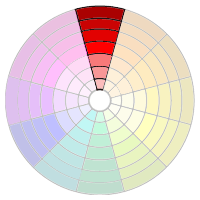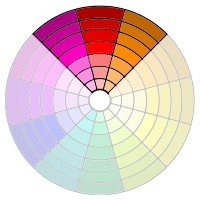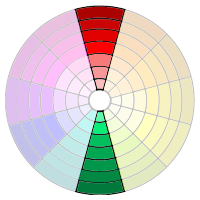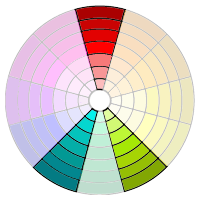Page Colors
Colors draw attention to a Web page. They focus interest on page elements and help to highlight important
information. Colors can also be distractive. Improperly used they can draw attention to themselves and
away from central page content. One of the most important choices you make as a page designer, then, is
a color scheme to complement or enhance information appearing on a Web page.
Color Wheel
A color wheel is a chart that shows how colors are related to make it easier to choose
harmonious color combinations that attract attention to page content. The color wheel is divided into
three categories of colors.
 Figure 11-9. Color wheel.
Figure 11-9. Color wheel.
 Figure 11-10. Tints and shades.
Figure 11-10. Tints and shades.
The primary colors are red,
yellow, and blue. These are the foundation colors from which
all other colors derive. They are called primary colors because no other colors can be mixed to
create these colors. They are evenly spaced around the color wheel.
Secondary colors are produced by combining any two of the primary colors. The three secondary
colors are orange (red + yellow),
green (yellow + blue), and violet (red + blue).
Tertiary colors are produced by mixing a primary color and an adjacent secondary color.
The six tertiary colors are red-orange,
red-violet,
yellow-green,
yellow-orange,
blue-green, and
blue-violet.
The purest value of a color is its hue. A color's tint is a lighter
value of the hue made by adding white; a color's shade is a darker value of the hue
made by adding black.
Picking Colors
When choosing colors for a Web site it is best to select only a few colors. You do not want to overpower
and detract from the information contained on the page; you want to complement or emphasize it.
Generally, you will pick a dominant color along with other colors that are analogous to it or that contrast with it. There are standard color-matching schemes that can be followed in picking these colors.
Color Wheel Pro - a unique software program that allows you
to see color theory in action. With Color Wheel Pro, you can create harmonious color schemes and preview
them on real-world examples.
Other useful color scheme Web sites include
Monochromatic

Figure 11-11. Monocromatic colors.
A monochromatic color scheme uses a single hue with various tints and shades for contrast. Normally
you will pick darker colors for text presentation and lighter colors for backgrounds. The various
tints and shadings range from bold to subtle, and you need to choose the combination that works well
for the message you are trying to get across and the mood you are trying to set.
Monochromatic Table Colors
| Section |
Hue |
Hex Value |
RGB Value |
|
Header
|
Red (dark)
|
#CC6666
|
204, 102, 102
|
|
Column
|
Red (light)
|
#FAC8C8
|
250, 200, 200
|
|
Background
|
Red (light)
|
#F6E1E1
|
246, 225, 225
|
Figure 11-12. Examples of monocromatic colors.
Analogous

Figure 11-13. Analogous colors.
An analogous color scheme uses adjacent hues and their tints and shadings. All of the colors share a
common hue, for example, red-violet, red, and red-orange.
The presentation and feeling is similar to a monochromatic scheme with a larger assortment of hues from
which to choose.
Analogous Table Colors
| Section |
Hue |
Hex Value |
RGB Value |
|
Header
|
Red-Violet (dark)
|
#C4028F
|
196, 2, 143
|
|
Column
|
Red-Orange (light)
|
#FFAD5B
|
255, 173, 91
|
|
Background
|
Red (light)
|
#FFCCCC
|
255, 204, 204
|
Figure 11-14. Examples of analogous colors.
Complementary

Figure 11-15. Complementary colors.
A complementary color scheme uses a hue on the opposite side of the color wheel from the dominant color.
This color combination provides the greatest contrast and makes both colors more intense and brighter
than when they are used alone.
Complementary Table Colors
| Section |
Hue |
Hex Value |
RGB Value |
|
Header
|
Red (dark)
|
#C4028F
|
196, 2, 143
|
|
Column
|
Green (dark)
|
#02D0BF
|
2, 208, 191
|
|
Background
|
Green (light)
|
#D0F2E0
|
208, 242, 224
|
Figure 11-16. Examples of complementary colors.
Split-Complementary

Figure 11-17. Split-complementary colors.
A split-complementary color scheme uses a hue along with two colors that are adjacent to its complement.
For example, if the dominant color is red, then split-complementary hues are yellow-green and blue-green.
Split-Complementary Table Colors
| Section |
Hue |
Hex Value |
RGB Value |
|
Header
|
Red (light)
|
#FF6666
|
255, 102, 102
|
|
Column
|
Blue-Green (dark)
|
#25EADA
|
37, 234, 218
|
|
Background
|
Yellow-Green (light)
|
#E6FBC6
|
230, 251, 198
|
Figure 11-18. Examples of split-complementary colors.
Triadic

Figure 11-19. Triadic colors.
A triadic color scheme uses three hues that are evenly spaced from each other on the color wheel.
For example, if the dominant color is red, then blue and yellow hues are the triadic complements.
Like the complementary color scheme, this one also emphasize the colors through their contrasts.
Triadic Table Colors
| Section |
Hue |
Hex Value |
RGB Value |
|
Header
|
Red (light)
|
#FF7575
|
255, 117, 117
|
|
Column
|
Blue (light)
|
#7676FB
|
118, 118, 153
|
|
Background
|
Yellow
|
#FFFF99
|
255, 255, 153
|
Figure 11-20. Examples of triadic colors.
Achromatic
Although they do not appear in the color wheel, don't forget about black, white, and the range of
gray tints that can be applied to highlight or emphasize page content. These achromatic tones can offer
high contrast or subtle shading.
Achromatic Table Colors
| Section |
Hue |
Hex Value |
RGB Value |
|
Header
|
50% Gray
|
#818181
|
255, 117, 117
|
|
Column
|
25% Gray
|
#C1C1C1
|
193, 193, 193
|
|
Background
|
5% Gray
|
#F6F6F6
|
246, 256, 256
|
Figure 11-21. Examples of achromatic colors.
Selecting a Color Palette
A half-dozen or so colors is normally a good starting point for building a pallet of analogous or
complementary colors for a page color scheme. In some cases you pick the colors based on preferences
or existing standards.

 United States Grand Prix
Indianapolis - 2003
United States Grand Prix
Indianapolis - 2003
Figure 11-22. Selecting a triadic color scheme.
When working with photographs, a good starting point is to select colors based on those appearing in the
picture. In the accompanying illustration, a palette of five colors, plus black and white, have been chosen
from the picture. Various muted shades of red and blue -- part of the triadic color scheme -- produce the
subtle contrast needed between text and background. The intent is to recede the text in order to bring the
picture to attention. These colors were extracted from the photograph using the Photoshop
eyedropper tool.
As a general rule, it is probably best to stay away from pure hues as is used in the second illustration.
Pure colors tend to be garish, with high contrast that can confuse the eye as to the point of focus. In
this case, the boldness of the text tends to draw attention away from the picture and towards the upper
and lower portions of the illustration. If that is the look you are going for, then fine, although there
are better ways to emphasize text without high contrast colors.

 United States Grand Prix
Indianapolis - 2003
United States Grand Prix
Indianapolis - 2003
Figure 11-23. Selecting pure hues.
With 16 million or so colors to choose from, it can be difficult picking the half-dozen you need for
your pages. An effective way of choosing colors is with various types of color-wheel software that is
available. Color Wheel Pro - a unique software program
that allows you to see color theory in action. With Color Wheel Pro, you can create harmonious color
schemes and preview them on real-world examples.